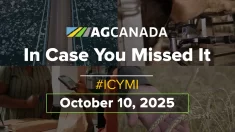Brian Hayward is now an author, but he is better known to farmers as CEO of United Grain Growers and Agricore United
Have you sat upon a board of directors with a terrible chairperson?
Have you been the chair of a board and wondered if you were doing a terrible job?
Do you even know what a chair is supposed to do and how to judge how well they’re doing it?These are questions Brian Hayward, a long-time agribusiness corporate leader and chair of many non-agricultural boards, ponders in his book The Great Chair.
“Why are some meetings so good, and why are some so crappy?” says Hayward in the introduction to this accessible guide to the generally unexplored topic of a chair’s role, responsibilities, potentials and risks.
Read Also

Saskatchewan firm aims to fix soil with compost pellets
In his business, Humaterra, Leon Pratchler is helping farmers maximize yields in the weakest areas of their fields through the use of a compost pellet.
“A great chair is an individual who can elevate peers, namely the board,” says Hayward in his conclusion.
“And by elevating board peers and the smart people who manage activity, the great chair elevates the organization.”
Hayward’s name is familiar to thousands of western Canadian farmers from his years as chief executive officer of Agricore United and United Grain Growers. However, since AU was consumed by Viterra, Hayward has had an impressive career as a board member and often board chair of companies in Canada and around the world, including Ridley Australia, Wellington West, Princess Auto, Farmers Edge and Business Development Canada.
In the book, Hayward lays out various true story situations of things going awry — or even disastrously bad — on boards upon which he has sat or chaired. While he has changed the names of the characters and companies involved, he says the situations are true to what he has experienced.
The 261-page book is filled with anecdotes, humour and illustrations to leaven what could be a heavy read, but instead reveals Hayward to be a gifted writer, humourist and even philosopher of board management.
He warns against “Swanson Dinner” agendas (same bland ingredients year after year after year), flags elementary board decision-making errors (such as taking a straw poll at the beginning of a discussion, pushing people into positions before airing the issue), highlights the difficulties of managing various personality types (especially narcissists) and lays out a philosophy for the constructive role the chair should be taking with directors and the chief executive officer.
While much of Hayward’s experience is on corporate boards, he has also been on other types of boards. He has aimed this book at people interested in any board, from community and non-governmental organizations, to co-operatives to businesses.
The COVID-19 pandemic has added unique challenges to many organizations, but Hayward uses it to add a coda to the book, with a philosophical rumination on the impact of unexpected shocks and what the board of directors and its chair should or should not do to prepare for the unpredictable.
“Nothing beats pressure, to stress-test pipes, processes and people. Throw the lever, push the button, let the steam rip. We’ll find where the leaks are and fix them — or not,” he writes.
Is the job of the chair to get the board to prepare during good times for every long-shot possibility and be hunkered down for every eventuality? Or is it to ensure the company is financially sound enough to withstand a shock like a pandemic, and to have the human skills and culture within the company and on the board to deal with crises?
Hayward favours the latter, and the focus upon the chair’s importance in creating a good culture within the board of directors and with the CEO is the hallmark of Hayward’s approach.
He writes that the idea for this book arose from him having many questions about boards and chair functions, yet he found little information about the whole area.
“After scouring and almost breaking the internet looking for answers, I arrived at another place…. I said to myself, ‘maybe I will commit some of my own thoughts to paper.’ ”
















